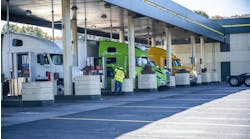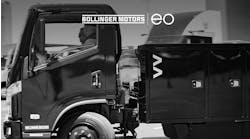Mack Trucks has wasted virtually no time in gaining for its just-announced MD Electric model an important approval from California's Hybrid and Zero-Emission Truck and Bus Voucher Incentive Project, which is a popular route for fleets operating in the Golden State seeking price breaks on all kinds of electric vehicles and hybrids.
The Mack MD Electric was unveiled with fanfare on the Work Truck Week 2023 show floor in Indianapolis in early March. The EV, with Class 6 and Class 7 variants, is Mack's second battery-electric model after the LR Electric refuse model, which began production two years ago. And the MD Electric joins the LR and others aboard California's HVIP, which aims to help accelerate the commercialization of zero-emission and near-zero emission trucks by offering point-of-sale vouchers that can help fleets afford them. The MD Electric is approved for an $85,000 voucher through HVIP, while the heavier LR Electric is cleared for a $120,000 voucher per vehicle.
At this point, EVs and hybrids are significantly more expensive than comparable conventional fuel-burning vehicles with internal combustion engines, so incentives help narrow the purchase-price gap and allow many fleets that otherwise couldn't afford them to pursue sustainable vehicle solutions.
See also: Daimler, Toyota strike deal to merge Fuso and Hino
"Mack applied to the HVIP administration to be included in the green funding project to help encourage the further adoption of battery-electric vehicles," George Fotopoulos, Mack Trucks vice president of e-mobility, said in a release from the OEM. "Inclusion in this program is another effort by Mack to drive decarbonization while also helping customers with their purchases."
The MD Electric will meet the needs of applications requiring dry van/refrigerated, stake/flatbed, and dump vocations, according to Mack. The Class 6 variant of the MD Electric does not require a CDL to operate when hauling non-hazardous payloads.
The Class 6 model of the MD Electric will have a gross vehicle weight rating (GVWR) of 25,995 lb., and the Class 7 variant (which does require a CDL to operate) has a GVWR of 33,000 lb. Both will be exempt from the 12% federal excise tax and produced at Roanoke Valley Operations in Virginia, where Mack began production of the Mack MD Series three years ago.
The MD Electric will be available in 4x2 configurations, featuring a sharp wheel cut for enhanced maneuverability in tight urban settings, according to another Mack statement that accompanied the early-March unveiling. The cab design features a short bumper-to-back-of-cab measurement of 103 inches. Similar to the diesel-powered Mack MD Series, the OEM matched the look and styling of its Anthem, Mack's on-highway model, as a basis for the MD Electric grille and hood design. The MD Electric will be supported by Mack dealers, many of which are certified EV dealers.
See also: Mack reveals Granite CNG model
The MD Electric's three-phase permanent magnet synchronous motor and on-board accessories are powered by nickel manganese cobalt oxide lithium-ion batteries, either in a 150-kilowatt (140-mile range) or 240-kilowatt (230-mile range) configuration. The MD Electric can be charged through AC or DC charging units. The regenerative braking system helps recapture energy from the multiple stops the vehicle makes each day.
HVIP eases path for fleets to procure EVs
Eligible OEMs and incentive amounts vary widely on the California HVIP website, which serves as a snapshot of how much EVs are blossoming, especially outside the long-haul over-the-road segment of the freight-hauling and handling industry. No less than 11 electric refuse models from various OEMs, including Mack's LR Electric, qualify for vouchers of up to $150,000 per vehicle through HVIP. Vouchers for Class 8s, hydrogen fuel-cell electric or full electric variants, go up to $240,000.
See also: Long-haul's journey to near-zero
More than 30 straight trucks, including the Mack MD Electric, qualify under the incentive program. Some fuel-cell electric vehicles, represented in the Class 8 category by OEMs Hyzon and Nikola, are approved, but most of the vehicles eligible for vouchers through the HVIP are battery electrics across all classes. They are represented by a who's who of manufacturers: BrightDrop, BYD, Crane, EVT, Freightliner, Freightliner Custom Chassis, GreenPower, Hexagon Purus Systems, Hyundai, International, Kenworth, Lightning eMotors, Lion Electric, Motiv, Nikola, Peterbilt, Phoenix, SEA Electric, Volvo, Workhorse, and Xos.
HVIP is designed to make sales happen. Vouchers directly benefit purchasers and dealers—helping close the price gap between advanced technology vehicles and their conventionally fueled counterparts—and California, by far, is the leader among states in offering incentives to fleets that seek to purchase full EVs and fuel-cell electric or hybrid commercial vehicles.
And HVIP is helping speed up technology transformation, at least in the Golden State. In 2018, the project received $176 million in requests, more than all eight previous years combined. Requests in 2022 totaled more than $240.3 million. Of the 730 zero-emission trucks on the road in California as of January 2022, more than 60% are directly funded by HVIP, according to the project's website.
Incentives expected to boost EV, hybrid market share
A total of 17 other states besides California have taken steps, including offering substantial incentives, toward zero-emissions (ZEV) or near-zero emissions vehicles, Andrew Wrobel, director of commercial vehicle and fleet research and advisory practice for Escalent, a Michigan-based market research and data sciences firm, said during a Work Truck Week session.
And incentives such as HVIP and those available in other states are helping to accelerate the percentage of commercial vehicles, especially in lighter-weight classes, that are going electric, according to statistics cited by Wrobel during the Green Truck Summit session.
See also: EV cost parity still a decade away: Ford CEO
For example, delivery and step vans are expected to be 45% battery-electric by 2030, he said. "Most electrification is being driven by vans. It's an easy segment to electrify," he said. In other classes, he added, that percentage will be lower: Classes 2B-3, 16% battery-electric, and Classes 4-5 will be 10% BEV in seven years. EVs will only represent a tiny percentage among the heaviest vehicles, Class 8s, even by 2023, he predicted, though hybrid powertrains will help sustainability among the over-the-road class.
"Find what works for your use case," Wrobel advised fleet operators at Work Truck Week. "ZEVs will get better over time, and the technology growth is happening very rapidly. Focus on works for you now. If there's TCO and incentive benefits (such as California's HVIP) and the technology works for your use case, it's worth considering."






